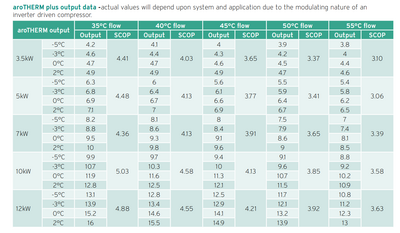Posted by: @jeffIt is not clear to me that you have a clear idea of what you want the final solution to achieve in terms of the conservatory? Perhaps you do in your head, but it doesn't come across in your posts.
I am also not clear on how much you use the conservatory through the year, how important is it to get it right.
My late mum had a lovely large conservatory on the back of her bungalow. She used it almost as much in winter as in summer I suspect, with a large double radiator in it. It had sofas and a dining table in it.
Ironically perhaps is was the most important and well used part of her home.
I can't tell how important the conservatory is for you, albeit you mention it many times.
As another example, the in-laws a have smaller conservatory that they have just had an insulated roof put on to replace a glass roof. It is now much cooler in summer, but to be honest they still hardly use it and it has a couple of cheap wall mounted convention heaters.
I wonder if you were clearer about what you want to achieve with the conservatory and how you use the home overall then it may be easier to compare solutions albeit there may still be a lot of variety across installers?
Interesting points, and I can see why you'd think this as the clarity on the conservatory has developed through the course of the quotation process. It started as a non-issue until the first surveyor, from Octopus (who was also doing the EPC), mentioned it as soon as he walked through the kitchen door and spotted it. At the end of his survey he said they could treat it in two ways, either as a habitable heated room with a target temperature in line with the living room, or as a room with a lower target temperature (16C, IIRC). At the time he almost steered me towards the first option based on the fact that I'd told him that we occasionally used it as a dining room (e.g. on Christmas Day), and it's factored into the Octopus quote in that way.
Subsequent to this, other designers have treated it in different ways, based on my discussions I've had with them. EDF initially discussed using TRV's to reduce the heating requirement in there when not required, which I liked the sound of, but then when their design team got involved they simply removed it from the planned system completely. It took 24-48hours after this discussion for me to realise that I didn't like that option at all. Since we moved into the house, the conservatory has been controlled by a separate thermostat to the remainder of the house, and it has been an irritant to both my wife and myself that it has, so I've concluded that I don't want it to be separated, even if there's an efficiency cost to doing so.
In the visits that took place last week, I've been able to discuss this with the surveyors with more clarity, and all have planned it into their designs, albeit with the fact that I'm relaxed about it being treated as an occasional room (one of them mentioned that there's a classification they can use in the MCS specs, but I can't recall what he called it, but it sounded like a good workaround from a design perspective).
We've also commenced a process, as a direct consequence of the heat pump exercise, to get quotations for updating the roof and/or glazing in the conservatory, which will ultimately reduce the heat loss within there and make it more like a normal room in the house. This may be via simple replacement of the roof panels with an insulated version, or a more complete replacement of doors, windows and roof with building reg certification which would enable it to be treated as an additional room in the house (and enable the external doors to access to be replaced with an internal door, which we didn't even realise was a restriction of the current set up). Consequently, it's strengthened the view that including the conservatory is the right option as it will ultimately become less of a heat loss challenge over the life that this installation will run for. If it's a design compromise at the point of install, it will become less of one at some point in the next year or two.
130m2 4 bed detached house in West Yorkshire
10kW Mitsubishi Ecodan R290 Heat Pump - Installed June 2025, currently running via Havenwise.
6.3kWp PV, 5kW Sunsynk Inverter, 3 x 5.3kWh Sunsynk Batteries
MyEnergi Zappi Charger for 1 EV (Ioniq5) and 1 PHEV (Outlander)
We have a summer house connected to the main house heating. The initial idea was to have it heated all the time, same as the house, but it soon became obvious the heating was really running only to keep the summer house warm. So plan 2, the more pragmatic approach, let the house dominate and the summer house get what it gets. So summer house floats over about 4 degs (17 to 20), if we want it hotter we just flick on a panel heater.in the summer house.
If you only use at say Christmas, just heat to 16, if need add a panel heater, or have it unheated, to get a realistic ASHP size, not dominated by an occasional use conservatory.
@sheriff-fatman the conservatory probably had a separate thermostat fitted to meet building regulations. Officially they need a separate thermostat but rarely do...
https://www.theconservatoryheatingcompany.co.uk/news/conservatory_heating_building/
You will find lots of conservatories out there without external rated doors and with TRVs only to control the temperature... some even open plan to the house.
My late mum had an external rated kitchen door and external rated living room patio doors into the conservatory but just a TRV on the radiators for example. No issues when selling the property in terms of EPC, survey, mortgage, insurance etc. So although officially a requirement it doesn't mean a lot in all the examples I have seen. Not to say you shouldn't comply with the law.
Posted by: @sheriff-fatmanthat including the conservatory is the right option as it will ultimately become less of a heat loss challenge over the life that this installation will run for. If it's a design compromise at the point of install, it will become less of one at some point in the next year or two
If that is the case then I would add to my earlier post:
I would try to avoid getting a heat pump now that will be significantly oversized once the conservatory is eventually upgraded.
I would also repeat the suggestion to consider cooling for the conservatory only. You mentioned up thread that it overheard, a new roof will improve that somewhat but with a large expanse of glass it's perhaps likely that it will continue to overheat. Fitting a fancoil in the conservatory and choosing a heat pump capable of cooling might be a good choice.
4kW peak of solar PV since 2011; EV and a 1930s house which has been partially renovated to improve its efficiency. 7kW Vaillant heat pump.
The outstanding heat loss calculations filtered through this week. I received 3 in total with sufficient detail to interrogate by room, which has allowed me to compare and contrast them, and doing so has proved to be eye-opening in seeing just why and how they vary.
The most glaring example of this is that for the two surveys where I can see the U Value assigned to the polycarbonate conservatory roof, one had used a figure of 0.25 and the other had used 5.11. The expected figure should, based on several internet searches, be 1.5-2.4 so neither calculation aligned to expectations on the room with the biggest design challenge in the house. The 5.11 figure is the equivalent to a single pane of glass and the 0.25 figure is something that a replacement roof might achieve.
I've managed to replicate one of the calculations (sent via PDF) into a spreadsheet so have now done my own set of calculations from this, adjusting some of the U value figures based on my own research. This has also allowed me to see the range of figures at different temperatures and get a better idea of what the heat pump will have to achieve across the range of temperatures it will work across at various times of year.
I'm now trying to find the true capacities of various heat pump models across the range of temperatures to see which appears to be the best fit, and will then go back to the quote providers still in the frame to discuss further. Vaillant data was easy to find in this regard, and it suggests that the 7kW Arotherm might be adequate, rather than the huge leap up to the 10kW dual fan model. Ideal heat pumps are proving more problematic, in terms of data, so if anyone has any figures on this that would be useful. Mitsubishi Ecodan data just seems to show a flat line at the stated power output across the temperature range, so I'm unconvinced by this so far.
Perhaps a table showing the output power for all popular models at varying temperatures would be a good resource to have on the forum, given how difficult it is to find in general.
130m2 4 bed detached house in West Yorkshire
10kW Mitsubishi Ecodan R290 Heat Pump - Installed June 2025, currently running via Havenwise.
6.3kWp PV, 5kW Sunsynk Inverter, 3 x 5.3kWh Sunsynk Batteries
MyEnergi Zappi Charger for 1 EV (Ioniq5) and 1 PHEV (Outlander)
Posted by: @sheriff-fatmanvarious heat pump models across the range of temperatures to see which appears to be the best fit, and will then go back to the quote providers still in
the frame to discuss further. Vaillant data was easy to find in this regard, and it suggests that the 7kW Arotherm might be adequate, rather than the huge leap up to the 10kW dual fan model. Ideal heat pumps are proving more problematic, in terms of data, so if anyone has any figures on this that would be useful. Mitsubishi Ecodan data just seems to show a flat line at the stated power output across the temperature range, so I'm unconvinced by this so far
A couple of hopefully helpful comments
Vaillant 10kW is the same as the 12kW, just software limited.
A neighbour of mine was borderline 7/10kW and also was happy to have his house at a slightly lower temp than MCS rules. Installer fitted 7kW and the backup heater which Vaillant sell (others do similar). Neighbour happy.
Mitsubishi have for some while clamped their output in software so it's the same at a range of fts and oats. No idea why.
Ideal figures are definitely on their website, I did once download them but don't have access at present.so can't help you on this.
I'm guessing that the guy who used a v low u value for the conservatory was trying to exclude it (effectively trying to help you) whilst covering his rear end.
In general it's only really necessary to do loss calculations at the design (lowest) temperature. Anything above that sorts itself out, unless you are doing something odd.
4kW peak of solar PV since 2011; EV and a 1930s house which has been partially renovated to improve its efficiency. 7kW Vaillant heat pump.
@jamespa I also suspect the 5.11 figure was used as a justification to exclude it from the design.
From what I can see on the Vaillant model, it's output is over 7kW across a range of outdoor temperatures and flow temperatures, to the extent that the 7kW 'label' looks odd.
The relevant issue from a design perspective seems to be that Vaillant require 120% coverage on the design calculation. Ours came out, according to one company, at 98-102%, which means that they would have to recommend the 10kW model to avoid potential warranty issues, which then does feel like an unnecessary oversizing given the leap in size of their particular range of pumps (especially as a restricted 12kW pump).
I suspect that my best route forward now, based on my own thoughts, is to stump up to get BOXT out to do their own survey, as they're currently quoting for a 7kW unit. If their own calculations justify it from MCS / BUS Grant / Warranty arse covering perspective then I think I'd end up with a solution of the right sizing. If they're forced upwards, then the fall-back would be to go to one of the other quotes based on Ecodan or Ideal solutions (8kW or 8.5kW models in both cases).
130m2 4 bed detached house in West Yorkshire
10kW Mitsubishi Ecodan R290 Heat Pump - Installed June 2025, currently running via Havenwise.
6.3kWp PV, 5kW Sunsynk Inverter, 3 x 5.3kWh Sunsynk Batteries
MyEnergi Zappi Charger for 1 EV (Ioniq5) and 1 PHEV (Outlander)
Posted by: @sheriff-fatmanFrom what I can see on the Vaillant model, it's output is over 7kW across a range of outdoor temperatures and flow temperatures, to the extent that the 7kW 'label' looks odd.
Just as a quick sense check, this is the Vaillant data that led me to the above quote. If I'm reading this correctly, then for all outside temperature/flow temp combinations shown, the 7kW model exceeds the stated value (other than for 55C flow temp at -5, at which point it hits 7kW).
Heat flow calculations suggest we're looking at an assessed heat loss of circa 8.9kW at -2.3C with the Conservatory 'as is', a situation that will likely be improved via a replacement of roof (and most likely glazing) in the near(ish) future, which will bring those numbers down further. Roof panels alone, using their advertised U value of 0.18, would bring the heat loss assessment to just under 8kW.
The supporting checks I've done from gas consumption (noted earlier in the thread) implied a requirement of 5-6kW when dividing by 2900, which would also suggest that the 7kW pump would do the job too, so there's other data (albeit they are all estimates in some form or other) to support this thinking, assuming that I've interpreted the table correctly.
Logically, the two alternatives of an 8kW Ideal Logic Air or an 8.5kW Mitsubishi Ecodan should also suffice, albeit with the caveat that I haven't yet seen Ideal's equivalent data, as I can't find it anywhere (so far, at least).
130m2 4 bed detached house in West Yorkshire
10kW Mitsubishi Ecodan R290 Heat Pump - Installed June 2025, currently running via Havenwise.
6.3kWp PV, 5kW Sunsynk Inverter, 3 x 5.3kWh Sunsynk Batteries
MyEnergi Zappi Charger for 1 EV (Ioniq5) and 1 PHEV (Outlander)
Posted by: @sheriff-fatmanJust as a quick sense check, this is the Vaillant data that led me to the above quote. If I'm reading this correctly, then for all outside temperature/flow temp combinations shown, the 7kW model exceeds the stated value (other than for 55C flow temp at -5, at which point it hits 7kW).
Correct. However unofficial data suggests this ignores defrosts and you might have to derate by 10-20pc when it's defrosting a lot, which in fairness is likely at a higher temp than -2.3 (when the load is of course less) because by the time you get to -2 it's usually, but not always, drier in the air. Alternatively it might be a bit marginal with the conservatory heated in its current state at very low temps, but do you care?
Posted by: @sheriff-fatmanHeat flow calculations suggest we're looking at an assessed heat loss of circa 8.9kW at -2.3C with the Conservatory 'as is', a situation that will likely be improved via a replacement of roof (and most likely glazing) in the near(ish) future, which will bring those numbers down further. Roof panels alone, using their advertised U value of 0.18, would bring the heat loss assessment to just under 8kW.
What value of air changes per hour is assumed?
If either the acs high or you are happy not to heat the conservatory when it's very cold I would personally lean towards the 7kW Vaillant or 8kW Mitsubishi (which has 2 compressors so a large modulation range). However it's a personal choice depending on approach to risk and how much heating the conservatory matters.
Don't forget to consider cooling for the conservatory, given you mentioned that this is needed. A fancoil should sort the future ability to do that (except possibly with the ideal hp which, from memory (but you should check) can't do cooking.
4kW peak of solar PV since 2011; EV and a 1930s house which has been partially renovated to improve its efficiency. 7kW Vaillant heat pump.
Posted by: @sheriff-fatmanVaillant data
Interesting data the 7kW has dramatic kW swings with OAT, while the 5 and 3.5kW have very little change. So would suggest the 5 and 3.5kW are software modified versions of a bigger unit. My Maxa ASHP is similar - almost flat output with respect OAT, but also very limited modulation.
Posted by: @AnonymousPosted by: @sheriff-fatmanVaillant data
Interesting data the 7kW has dramatic kW swings with OAT, while the 5 and 3.5kW have very little change. So would suggest the 5 and 3.5kW are software modified versions of a bigger unit. My Maxa ASHP is similar - almost flat output with respect OAT, but also very limited modulation.
Good spot on the data. The physical size of the 7,kW model is different however so I don't think it's likely the 5 is entirely a SW mod of the 7, however maybe there are some common components. There is some evidence that the 5 suffers fewer minor annoyances than the 7 so that's probably the one to go for if it fits the bill. That said my 7kW Vaillant has turned out pretty well!
4kW peak of solar PV since 2011; EV and a 1930s house which has been partially renovated to improve its efficiency. 7kW Vaillant heat pump.
Posted by: @jamespaWhat value of air changes per hour is assumed?
It varies by room, but the conservatory is assumed at 2 per hour, as is the kitchen, hallway and landing.
Living room and upstairs office are assumed at 1.5, bedrooms at 1, and bathroom/toilets at 3.
Two calculations both use similar figures, with the exception that one of them assumes 2 for the ensuite and downstairs toilet, rather than 3, so I assume they have some sort of common reference point to estimate this.
One of the calculations excludes the conservatory, so I only have one calculation showing a figure for this. Within my replicated spreadsheet I can manipulate the figure and each additional digit adds about 400W to the conservatory ventilation heat loss.
130m2 4 bed detached house in West Yorkshire
10kW Mitsubishi Ecodan R290 Heat Pump - Installed June 2025, currently running via Havenwise.
6.3kWp PV, 5kW Sunsynk Inverter, 3 x 5.3kWh Sunsynk Batteries
MyEnergi Zappi Charger for 1 EV (Ioniq5) and 1 PHEV (Outlander)
- 26 Forums
- 2,357 Topics
- 53.5 K Posts
- 168 Online
- 6,025 Members
Join Us!
Worth Watching
Latest Posts
-

RE: Setback savings - fact or fiction?
I could, but I think we can do better, by plotting hour...
By cathodeRay , 8 hours ago
-
RE: Midea ASHP – how to set weather compensation
Just one more thought. If you have convenient space fo...
By JamesPa , 10 hours ago
-
RE: Advice on internal circulation pump noise
Extend the primary branch and make sure you have more t...
By ASHP-BOBBA , 11 hours ago
-

RE: External pipework insulation
Oh Dear! that's appalling pipe work, should've been in ...
By dgclimatecontrol , 16 hours ago
-

RE: Jokes and fun posts about heat pumps and renewables
By Morgan , 16 hours ago
-

RE: Controlling Daikin Altherma via P1P2 and Home Assistant
On the contrary, @toodles, that’s a lot of help. I’d ne...
By Majordennisbloodnok , 18 hours ago
-
RE: Octopus Cosy Heat Pump Owners & Discussion Thread
@kevh with the Cosy 6 I know it definitely goes to arou...
By HarrisonC , 1 day ago
-

Parsnip, Bacon & Coconut Milk Soup
First let me say, I am only a cook because I am human a...
By Toodles , 1 day ago
-
RE: Electricity price predictions
Ben Watts posted on LinkedIn that he had updated this w...
By Judith , 2 days ago
-

RE: The good, the bad and the not that great – my heat pump installation
Small update, Emailed and Spoke to Midea UK and they ...
By Burtis , 2 days ago
-
RE: Solis S6-EH1P8K-L-PLUS – Why I Chose It and What I’ve Learned So Far
@bash Octopus does charge for the admin. The process al...
By Batpred , 2 days ago
-
RE: New Fogstar 15.5kWh upright solution
Issues still under investigation by Solis... Fogstar ...
By Batpred , 2 days ago
-
RE: Who's your electricity provider and what's your tariff?
I agree, the consumer is not being properly represented...
By Batpred , 2 days ago
-

RE: Heat Pump Heats the House… But It’s Not Cosy. Emitter Changes or System Tweak?
@toodles interesting suggestion, thanks. I will try to...
By GrahamF , 2 days ago
-
RE: Mitsubishi Ecodan Auto Adaption trial to stop cycling.
The interval you talk of, i think, will be 60min for an...
By F1p , 2 days ago
-
Agree with @majordennisbloodnok on the setbacks. We hav...
By ChandyKris , 3 days ago
-

RE: Speedcomfort radiator fans
@deltona the way the links were added broke the page. A...
By Mars , 3 days ago
-

RE: Refrigerant R32, is it now banned in the EU from 1st Jan 2027 for monobloc ASHPs?
This has been delayed from what I believe to be this ye...
By dgclimatecontrol , 3 days ago





